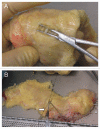Surgical aspects of human islet isolation
- PMID: 21099323
- PMCID: PMC3230558
- DOI: 10.4161/isl.2.5.13019
Surgical aspects of human islet isolation
Abstract
Islet transplantation is a safe and effective procedure; however, it depends on the critical step of isolating high quality of islets from whole pancreas. Human islet isolation requires considerable experience and expertise, and is frequently seen as 'an art rather than a science'. However, without scientific knowledge of pancreatic anatomy, real experience can not be gained. In particular, an understanding ductal anatomy is important to perform human islet isolation. This review is based on clinical experience of more than 900 human islet isolations performed over 10 years and aims to highlight pancreatic anatomy and surgical techniques in islet processing.
Figures













Similar articles
-
Heterogeneity of human pancreata in perspective of the isolation of the islets of langerhans.Transplant Proc. 2008 Mar;40(2):367-9. doi: 10.1016/j.transproceed.2007.12.022. Transplant Proc. 2008. PMID: 18374070
-
Efficacy of human islet isolation from the tail section of the pancreas for the possibility of living donor islet transplantation.Transplantation. 2004 Sep 27;78(6):839-43. doi: 10.1097/01.tp.0000130177.03326.d5. Transplantation. 2004. PMID: 15385802
-
Calcium: A Crucial Potentiator for Efficient Enzyme Digestion of the Human Pancreas.Cell Transplant. 2018 Jul;27(7):1031-1038. doi: 10.1177/0963689718779350. Epub 2018 Jun 26. Cell Transplant. 2018. PMID: 29945463 Free PMC article.
-
Isolation of adult porcine islets of Langerhans.Cell Transplant. 2000 May-Jun;9(3):297-305. doi: 10.1177/096368970000900301. Cell Transplant. 2000. PMID: 10972329 Review.
-
Successful clinical islet isolation using a GMP-manufactured collagenase and neutral protease.Transplantation. 2009 Sep 27;88(6):753-6. doi: 10.1097/TP.0b013e3181b443ae. Transplantation. 2009. PMID: 19920770 Free PMC article. Review.
Cited by
-
Ca2+ Oscillations, Waves, and Networks in Islets From Human Donors With and Without Type 2 Diabetes.Diabetes. 2022 Dec 1;71(12):2584-2596. doi: 10.2337/db22-0004. Diabetes. 2022. PMID: 36084321 Free PMC article.
-
A case of double common bile duct in a deceased donor for transplantation.Surg Radiol Anat. 2017 Dec;39(12):1409-1411. doi: 10.1007/s00276-017-1874-3. Epub 2017 May 18. Surg Radiol Anat. 2017. PMID: 28523346 Free PMC article.
-
Improved glucose tolerance with DPPIV inhibition requires β-cell SENP1 amplification of glucose-stimulated insulin secretion.Physiol Rep. 2020 Apr;8(8):e14420. doi: 10.14814/phy2.14420. Physiol Rep. 2020. PMID: 32339440 Free PMC article.
-
The effects of free fatty acid-free bovine serum albumin and palmitate on pancreatic β-cell function.Islets. 2025 Dec;17(1):2479911. doi: 10.1080/19382014.2025.2479911. Epub 2025 Mar 16. Islets. 2025. PMID: 40091018 Free PMC article.
-
Systematic review of islet cryopreservation.Islets. 2018 Jan 2;10(1):40-49. doi: 10.1080/19382014.2017.1405202. Epub 2018 Jan 9. Islets. 2018. PMID: 29315020 Free PMC article.
References
-
- Shapiro AM, Lakey JR, Ryan EA, Korbutt GS, Toth E, Warnock GL, et al. Islet transplantation in seven patients with type 1 diabetes mellitus using a glucocorticoid-free immunosuppressive regimen. N Engl J Med. 2000;343:230–238. - PubMed
-
- Ryan EA, Paty BW, Senior PA, Bigam D, Alfadli E, Kneteman NM, et al. Five-year follow-up after clinical islet transplantation. Diabetes. 2005;54:2060–2069. - PubMed
-
- Gruessner RWG, Sutherland DER, Kandaswamy R, Gruessner AC. Over 500 solitary pancreas transplants in nonuremic patients with brittle diabetes mellitus. Transplantation. 2008;85:42–47. - PubMed
-
- Bellin M, Barton F, Hering B the investigators of the Collaborative Islet Transplant Registry, author. Induction immunosuppression with T-cell depleting antibodies facilitates longterm insulin independence after islet allotransplantation in type 1 diabetes. Xenotransplantation. 2009;16:541.
-
- Danovitch GM, Cohen DJ, Weir MR, Stock PG, Bennett WM, Christensen LL, et al. Current status of kidney and pancreas transplantation in the United States 1994–2003. Am J Transplant. 2005;5:904–915. - PubMed
Publication types
MeSH terms
LinkOut - more resources
Full Text Sources
